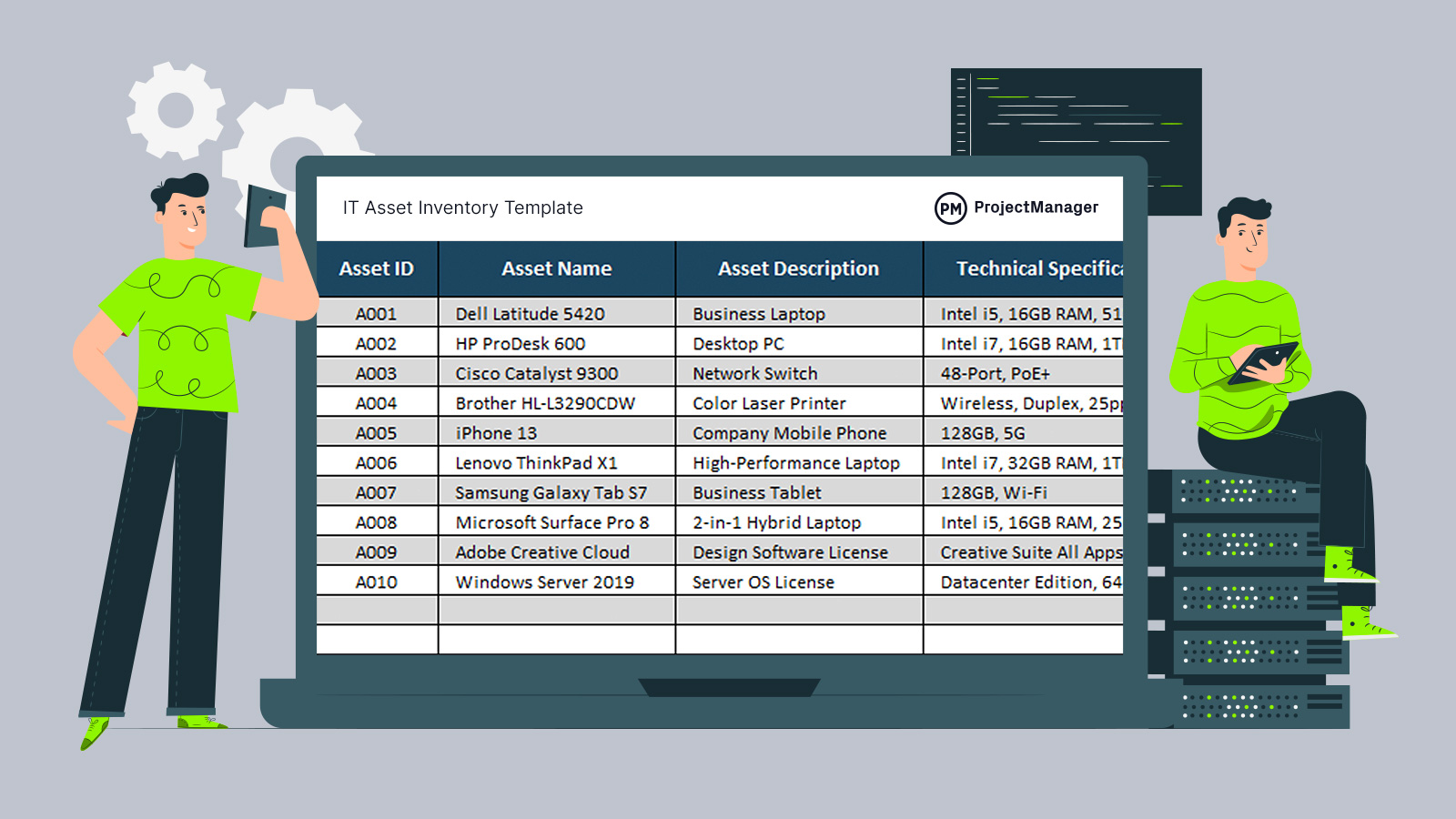An IT asset inventory template is a structured tool that helps businesses track and manage their hardware, software and other technology resources in one place. It provides a clear overview of what assets are owned, where they are located, who uses them and their current condition or lifecycle status. This makes it easier to control costs, reduce downtime and ensure compliance with licensing and security policies.
Download this free IT asset inventory template to organize key details such as asset ID, purchase date, warranty information, assigned user and maintenance schedule. It is easy to customize to fit your organization’s needs and can be used to track assets across multiple departments or locations. Download it now and take the first step toward better IT asset management.
While a template is helpful, project management software goes further by offering dynamic features that a static spreadsheet cannot. It allows for real-time updates, collaborative access and built-in tracking tools that make managing assets faster and more accurate. Integrations with other systems also improve reporting and oversight.
ProjectManager is ideal for managing IT asset inventory thanks to its powerful list view, which shows all the inventory, but with more functionality than a template. Combined with real-time dashboards, resource tracking and secure data sharing, it provides a complete solution for IT teams looking to stay organized and efficient. Get started with ProjectManager today for free.
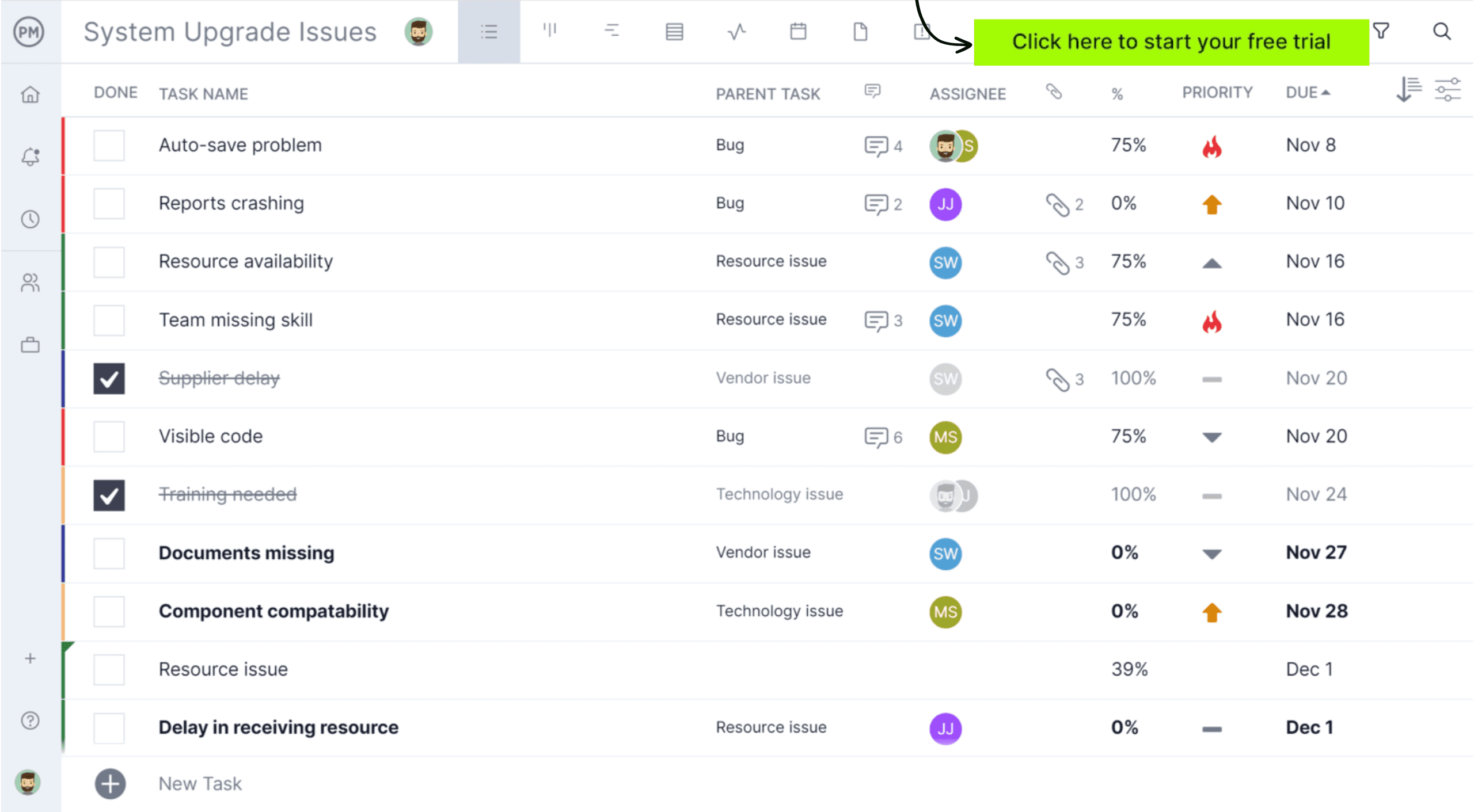
Why You Need an IT Asset Inventory Template
An IT asset inventory template is essential for maintaining a clear record of all hardware, software and digital resources in an organization. It helps ensure that every item is properly tracked, from purchase through its lifecycle, reducing the risk of loss, theft or overlooked updates. Accurate records also make budgeting for upgrades and replacements much easier.
Using a template also supports compliance with software licenses and industry regulations. It provides a centralized view of assets, making audits simpler and reducing the chance of penalties or downtime due to untracked equipment or expired licenses. A well-maintained inventory improves efficiency and ensures IT teams can make data-driven decisions.

When to Use an IT Asset Inventory Template
An IT asset inventory template should be used whenever an organization needs a structured way to record and track hardware, software and other digital resources. It’s particularly useful during initial inventory setup, routine audits or when onboarding new equipment into the system. Having a standardized format ensures all necessary details—such as purchase dates, warranty information and assigned users—are consistently captured.
This template is also valuable when planning for upgrades, budgeting for replacements or ensuring compliance with licensing agreements and regulations. By using it regularly, IT teams maintain visibility over asset lifecycles, reduce downtime and avoid costly oversights related to expired warranties or untracked equipment.
Who Should Use This Free IT Asset Inventory Template?
This free IT asset inventory template is ideal for IT managers, system administrators and operations teams who need to monitor and manage company assets efficiently. It also benefits finance teams responsible for budgeting and tracking asset depreciation, as well as compliance officers ensuring regulatory requirements are met.
Small businesses, startups and growing organizations can use it to establish a reliable inventory system without investing in expensive tools. Larger enterprises may adopt it as a supplemental resource for specific projects or audits, ensuring asset records remain accurate and up to date across departments.
How to Use This IT Asset Inventory Template for Excel
The IT asset inventory template provides a structured way to catalog and manage all your hardware and software assets. By filling out key sections, you ensure your organization has accurate records for tracking usage, maintenance schedules and lifecycle costs. Follow these steps to complete each section effectively.
1. Assign an ID Code, Name and Description to Each IT Asset
Begin by assigning a unique ID code to each IT asset. This makes tracking and referencing specific equipment simple across reports and audits. Include a clear asset name and a concise description that outlines its purpose and primary function. These details help teams quickly identify each item in the inventory. Avoid duplicate codes and keep descriptions consistent for better organization.
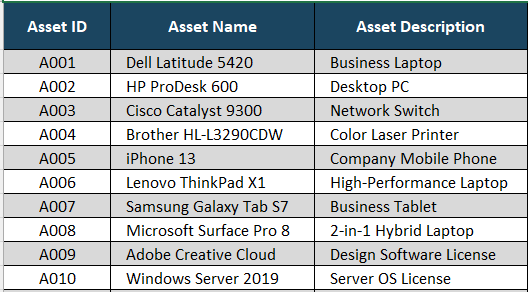
2. Describe the Technical Specifications and Category for IT Assets
Documenting technical specifications ensures you capture important details like model number, serial number, operating system and capacity. Include the category of the asset, such as laptop, server or network device. Accurate technical information is essential for troubleshooting, warranty claims and upgrades. Standardize terminology to avoid confusion and keep specifications updated as equipment is replaced or modified over time.

3. Identify the Business Department and Location Where IT Assets Will Be
List the department responsible for each asset and its physical or virtual location. Knowing where equipment resides and who uses it improves accountability and streamlines asset retrieval during audits. This information also supports budgeting for department-specific IT needs. Keep location data current, especially when assets are moved between offices or remote users. Doing so prevents loss and ensures accurate reporting.

4. Monitor the Status of IT Assets
Tracking the status of each IT asset helps determine whether it is active, in repair, retired or awaiting disposal. This allows teams to see which assets are available for use and which require maintenance or replacement. Maintaining accurate status information helps optimize resource allocation and prevent downtime. Update statuses regularly to reflect real-time changes and avoid discrepancies during audits.
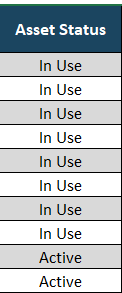
5. Track Purchase Costs and Purchase Dates for IT Assets
Recording purchase costs and dates provides insight into the financial lifecycle of IT assets. This data supports budgeting, depreciation calculations and cost analyses for future procurement. By knowing when an asset was purchased and its initial expense, organizations can plan for timely upgrades and replacements. Ensure this section is consistently updated for accurate financial reporting and resource planning.

6. Identify the Supplier of IT Assets
Documenting supplier information helps maintain strong vendor relationships and simplifies future purchases or warranty claims. Include details like supplier name, contact information and support agreements for quick reference. Tracking suppliers also assists in evaluating vendor performance and consolidating procurement to trusted sources. Keeping this information current ensures smooth communication and faster resolution of issues when support or replacements are needed.
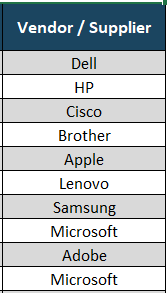
Related IT Project Management Templates
Managing IT projects requires organized tools to plan, track and execute work efficiently. These related templates help teams align goals, outline deliverables and respond to challenges with structured documentation.
IT Roadmap Template
Download this free template to create a visual timeline of IT initiatives, milestones and long-term goals. It helps align technology investments with business strategies, ensuring resources are allocated to the right priorities.
IT Project Plan Template
This free IT project plan template outlines project scope, objectives, tasks and timelines. It serves as a guide for managing deliverables, assigning responsibilities and keeping the project on schedule.
IT Incident Report Template
This free template standardizes the process of logging IT issues, tracking root causes and documenting resolutions. It helps teams respond quickly, minimize downtime and improve system reliability.
How to Manage IT Projects With ProjectManager
ProjectManager replaces static spreadsheets with live planning that fits how IT teams work. Switch views as needs change. Use the Gantt chart to schedule tasks, set dependencies and lock a baseline for progress checks.
Move to list view for fast updates and bulk edits. Run agile cycles on kanban to visualize flow and limit work in progress. Check calendar view to line up releases, maintenance windows and stakeholder deadlines so nothing slips.
Optimize Resource Management
Balance workloads with real-time availability and a color-coded workload chart that flags overbooking fast. The team page shows who is doing what and when, so you can reassign tasks with drag and drop and keep timelines realistic.
Track skills and roles to route incidents and project work to the right people, reduce context switching and protect sprint capacity across infrastructure, security and application teams.
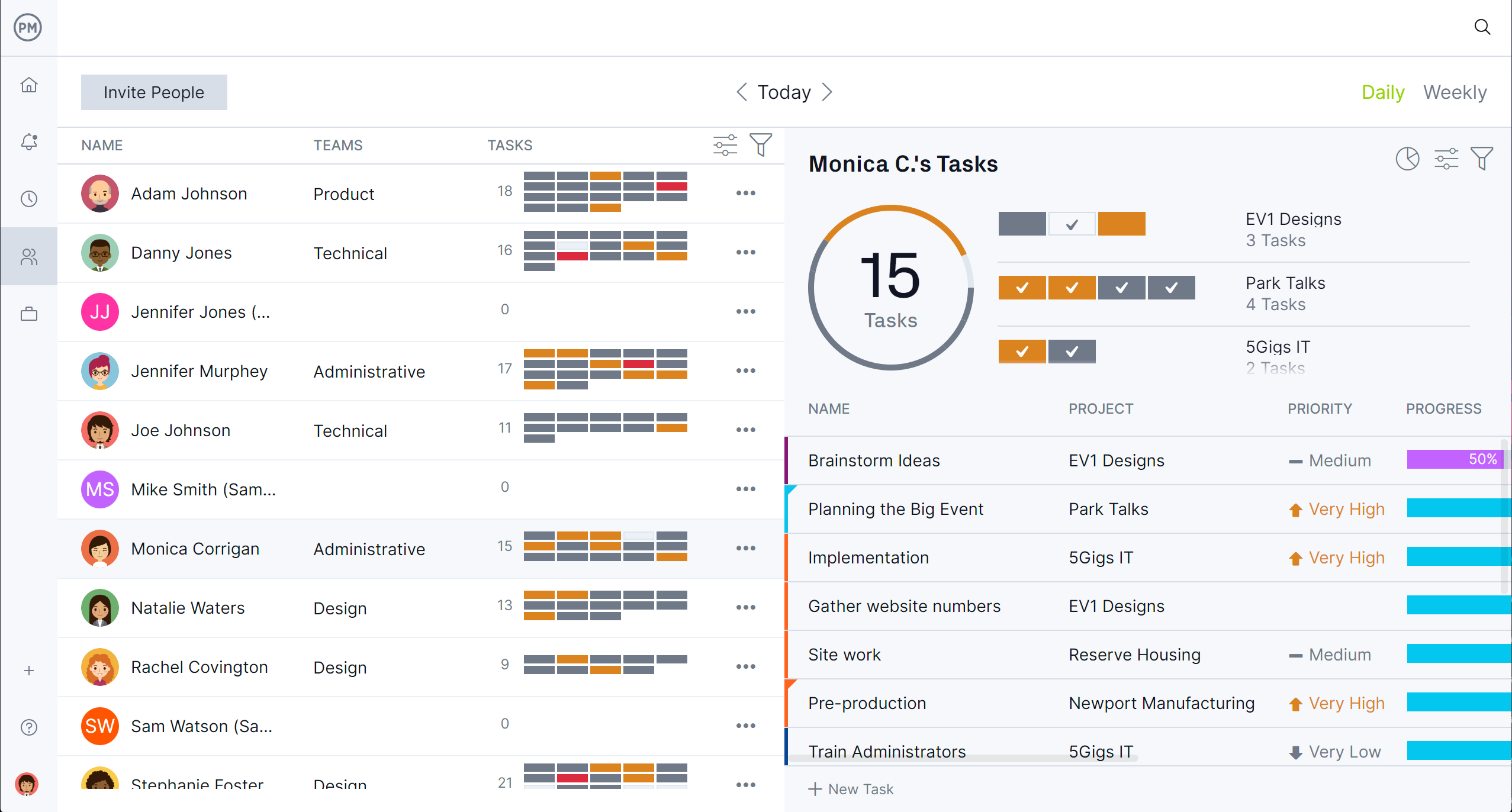
Track IT Projects in Real Time
See portfolio health at a glance with live dashboards that surface schedule, cost and workload indicators. Build customizable reports to highlight release readiness, change failure rate and open risks for CAB or leadership reviews.
Use secure timesheets to capture effort accurately for chargebacks and compliance while feeding plan vs actual so you can forecast with confidence and adjust before issues escalate.

Related Project Requirements Management Content
An IT asset inventory template is only part of the larger project requirements management process. For readers who want to learn more about this subject, below are some links to articles on IT project management, budgets, risk management and more.
- IT Project Management: The Ultimate Guide
- IT Asset Management: How to Manage Your IT Assets
- What Is an IT Roadmap? (Template Included)
- What Is an IT Budget? IT Budgeting Basics
- IT Risk Management Process, Frameworks & Templates
- IT Incident Management: How to Manage IT Incidents
ProjectManager is online project and portfolio management software that connects teams, whether they’re in the office or out in the field. They can share files, comment at the task level and stay updated with email and in-app notifications. Join teams at Avis, Nestle and Siemens who are using our software to deliver successful projects. Get started today with ProjectManager for free.
